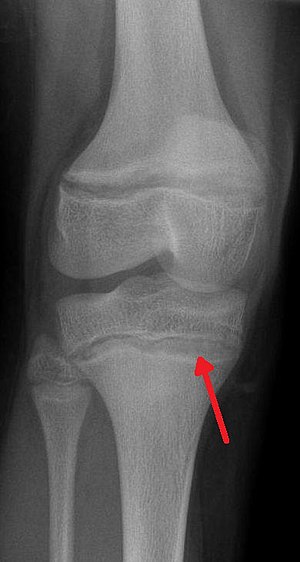Metaphyses
| Metaphysis | |
|---|---|

Structure of a long bone showing the metaphysis.
|
|
| Details | |
| Identifiers | |
| Latin | metaphysis |
| TA | A02.0.00.022 |
| FMA | 24014 |
|
Anatomical terminology
[]
|
|
| Example of metaphyseal lines in lead poisoning case | |
|---|---|
| Synonyms | Plumbism, colica pictorum, saturnism, Devon colic, painter's colic |
 |
|
| An X ray demonstrating the characteristic finding of lead poisoning in humans—dense metaphyseal lines. | |
| Classification and external resources | |
| Specialty | Toxicology |
The metaphysis (/mətˈæfɪsɪs/) is the narrow portion of a long bone between the epiphysis and the diaphysis. It contains the growth plate, the part of the bone that grows during childhood and as it grows, it ossifies near the diaphysis and the epiphyses.
The metaphysis may be divided anatomically into three components based on tissue content: a cartilaginous component (epiphyseal plate), a bony component (metaphysis) and a fibrous component surrounding the periphery of the plate. The growth plate synchronizes chondrogenesis with osteogenesis or interstitial cartilage growth with appositional bone growth at the same that it is growing in width, bearing load, and responding to local and systemic forces and factors.
During childhood, the growth plate contains the connecting cartilage enabling the bone to grow; at adulthood (between the ages of 18 to 25 years), the components of the growth plate stop growing altogether and completely ossify into solid bone. In an adult, the metaphysis functions to transfer loads from weight-bearing joint surfaces to the diaphysis.
Because of their rich blood supply and vascular stasis, metaphyses of long bones are prone to hematogenous spread of osteomyelitis in children.
Metaphyseal tumors or lesions include osteosarcoma, chondrosarcoma, fibrosarcoma, osteoblastoma, enchondroma, fibrous dysplasia, simple bone cyst, aneurysmal bone cyst, non-ossifying fibroma, and osteoid osteoma.
...
Wikipedia
